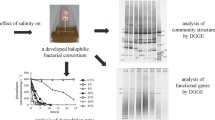Abstract
A halophilic bacterial consortium that degraded phenanthrene was developed from oil-contaminated saline soil containing 10% salinity. The biodegradation of phenanthrene occurred at 5%, 10%, and 15% salinity, whereas no biodegradation took place at 0.1% and 20% salinity. A 16S rRNA gene analysis showed that all sequences from the denaturing gradient gel electrophoresis profile were similar to those of halophilic bacteria. This is the first report of a halophilic bacterial consortium capable of degrading phenanthrene under hypersaline conditions.




Similar content being viewed by others
References
Altschul SF, Gish W, Miller W et al (1990) Basic local alignment search tool. J Mol Biol 215:403–410
Bertrand JC, Almallah M, Acquaviva M, Mille G (1990) Biodegradation of hydrocarbons by an extremely halophilic archaebacterium. Lett Appl Microbiol 11:260–263
Brito EM, Guyoneaud R, Goni-Urriza M et al (2006) Characterization of hydrocarbonoclastic bacterial communities from mangrove sediments in Guanabara Bay, Brazil. Res Microbiol 157:752–762
Garcia MT, Ventosa A, Mellado E (2005) Catabolic versatility of aromatic compound-degrading halophilic bacteria. FEMS Microbiol Ecol 54:97–109
Geiselbrecht AD, Hedlund BP, Tichi MA, Staley JT (1998) Isolation of marine polycyclic aromatic hydrocarbon (PAH)-degrading Cycloclasticus strains from the Gulf of Mexico and comparison of their PAH degradation ability with that of Puget sound Cycloclasticus strains. Appl Environ Microbiol 64:4703–4710
Geiselbrecht AD, Herwig RP, Deming JW, Staley JT (1996) Enumeration and phylogenetic analysis of polycyclic aromatic hydrocarbon-degrading marine bacteria from Puget sound sediments. Appl Environ Microbiol 62:3344–3349
Green SJ, Michel FC Jr, Hadar Y, Minz D (2004) Similarity of bacterial communities in sawdust- and straw-amended cow manure composts. FEMS Microbiol Lett 233:115–123
Guerin WF, Jones GE (1988) Two-stage mineralization of phenanthrene by estuarine enrichment cultures. Appl Envir Microbiol 54:929–936
Hedlund BP, Geiselbrecht AD, Bair TJ, Staley JT (1999) Polycyclic aromatic hydrocarbon degradation by a new marine bacterium, Neptunomonas naphthovorans gen. nov., sp. nov. Appl Environ Microbiol 65:251–259
Kasai Y, Kishira H, Harayama S (2002) Bacteria belonging to the genus Cycloclasticus play a primary role in the degradation of aromatic hydrocarbons released in a marine environment. Appl Envir Microbiol 68:5625–5633
Kasai Y, Shindo K, Harayama S, Misawa N (2003) Molecular characterization and substrate preference of a polycyclic aromatic hydrocarbon dioxygenase from Cycloclasticus sp. strain A5. Appl Environ Microbiol 69:6688–6697
Kleinsteuber S, Riis V, Fetzer I et al (2006) Population dynamics within a microbial consortium during growth on diesel fuel in saline environments. Appl Envir Microbiol 72:3531–3542
Li J, Bai R (2005) Effect of a commercial alcohol ethoxylate surfactant (C11–15E7) on biodegradation of phenanthrene in a saline water medium by Neptunomonas naphthovorans. Biodegradation 16:57–65
Margesin R, Schinner F (2001) Biodegradation and bioremediation of hydrocarbons in extreme environments. Appl Microbiol Biotechnol 56:650–663
McKew BA, Coulon F, Osborn AM et al (2007) Determining the identity and roles of oil-metabolizing marine bacteria from the Thames estuary, UK. Environ Microbiol 9:165–176
Melcher RJ, Apitz SE, Hemmingsen BB (2002) Impact of irradiation and polycyclic aromatic hydrocarbon spiking on microbial populations in marine sediment for future aging and biodegradability studies. Appl Envir Microbiol 68:2858–2868
Menzie CA, Potocki BB, Santodonato J (1992) Exposure to carcinogenic PAH in the environment. Environ Sci Technol 26:1278–1284
Nicholson CA, Fathepure BZ (2004) Biodegradation of benzene by halophilic and halotolerant bacteria under aerobic conditions. Appl Environ Microbiol 70:1222–1225
Nicholson CA, Fathepure BZ (2005) Aerobic biodegradation of benzene and toluene under hypersaline conditions at the Great Salt Plains, Oklahoma. FEMS Microbiol Lett 245:257–262
Menn FM, Applegate BM, Sayler GS (1993) NAH plasmid-mediated catabolism of anthracene and phenanthrene to naphthoic acids. Appl Environ Microbiol 59:1938–1942
Quesada E, Bejar V, Valderrama MJ, Ramos-Cormenzana A (1987) Growth characteristics and salt requirement of Deleya halophila in a defined medium. Current Microbiol 16:21–25
Sepic E, Bricelj M, Leskovsek H (1998) Degradation of fluoranthene by Pasteurella sp. IFA and Mycobacterium sp. PYR-1: Isolation and identification of metabolites. J Appl Microbiol 85:746–754
Ventosa A, Nieto JJ, Oren A (1998) Biology of moderately halophilic aerobic bacteria. Microbiol. Mol Biol Rev 62:504–544
Whitehouse BG (1984) The effects of temperature and salinity on the aqueous solubility of polynuclear aromatic hydrocarbons. Mar Chem 14:319–332
Acknowledgments
We gratefully thank Professor Ton van Brussel (Leiden University, The Netherlands) for careful reading of the manuscript. This research was supported by the Major State Basic Research Development Program of China (No. 2004CB418506), the National Natural Science Foundation of China (No. 30700023), and the Postdoctoral Science Foundation of China (No. 20060400069).
Author information
Authors and Affiliations
Corresponding author
Rights and permissions
About this article
Cite this article
Zhao, B., Wang, H., Mao, X. et al. Biodegradation of Phenanthrene by a Halophilic Bacterial Consortium Under Aerobic Conditions. Curr Microbiol 58, 205–210 (2009). https://doi.org/10.1007/s00284-008-9309-3
Received:
Revised:
Accepted:
Published:
Issue Date:
DOI: https://doi.org/10.1007/s00284-008-9309-3




